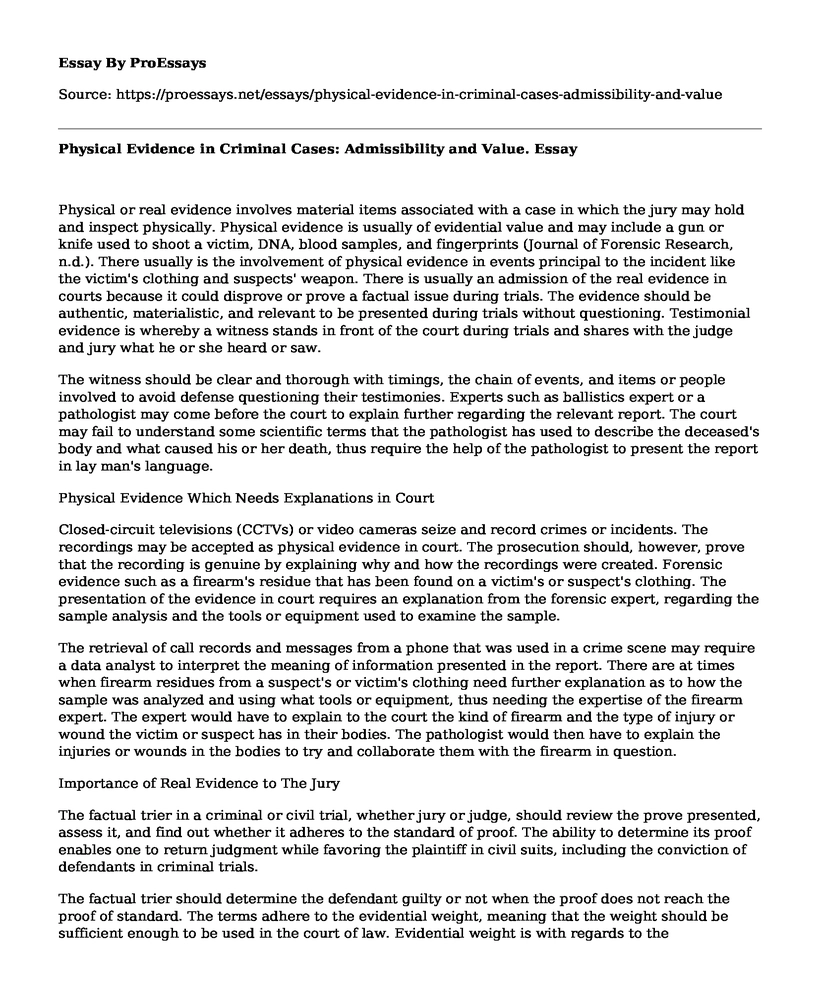Physical or real evidence involves material items associated with a case in which the jury may hold and inspect physically. Physical evidence is usually of evidential value and may include a gun or knife used to shoot a victim, DNA, blood samples, and fingerprints (Journal of Forensic Research, n.d.). There usually is the involvement of physical evidence in events principal to the incident like the victim's clothing and suspects' weapon. There is usually an admission of the real evidence in courts because it could disprove or prove a factual issue during trials. The evidence should be authentic, materialistic, and relevant to be presented during trials without questioning. Testimonial evidence is whereby a witness stands in front of the court during trials and shares with the judge and jury what he or she heard or saw.
The witness should be clear and thorough with timings, the chain of events, and items or people involved to avoid defense questioning their testimonies. Experts such as ballistics expert or a pathologist may come before the court to explain further regarding the relevant report. The court may fail to understand some scientific terms that the pathologist has used to describe the deceased's body and what caused his or her death, thus require the help of the pathologist to present the report in lay man's language.
Physical Evidence Which Needs Explanations in Court
Closed-circuit televisions (CCTVs) or video cameras seize and record crimes or incidents. The recordings may be accepted as physical evidence in court. The prosecution should, however, prove that the recording is genuine by explaining why and how the recordings were created. Forensic evidence such as a firearm's residue that has been found on a victim's or suspect's clothing. The presentation of the evidence in court requires an explanation from the forensic expert, regarding the sample analysis and the tools or equipment used to examine the sample.
The retrieval of call records and messages from a phone that was used in a crime scene may require a data analyst to interpret the meaning of information presented in the report. There are at times when firearm residues from a suspect's or victim's clothing need further explanation as to how the sample was analyzed and using what tools or equipment, thus needing the expertise of the firearm expert. The expert would have to explain to the court the kind of firearm and the type of injury or wound the victim or suspect has in their bodies. The pathologist would then have to explain the injuries or wounds in the bodies to try and collaborate them with the firearm in question.
Importance of Real Evidence to The Jury
The factual trier in a criminal or civil trial, whether jury or judge, should review the prove presented, assess it, and find out whether it adheres to the standard of proof. The ability to determine its proof enables one to return judgment while favoring the plaintiff in civil suits, including the conviction of defendants in criminal trials.
The factual trier should determine the defendant guilty or not when the proof does not reach the proof of standard. The terms adhere to the evidential weight, meaning that the weight should be sufficient enough to be used in the court of law. Evidential weight is with regards to the persuasiveness or believability of evidence. The probative value of proof depends on witnesses' persuasiveness compared to the number. The jury can determine whether the evidence has evidential value for a particular case.
Demonstrative Evidence and Proof to The Jury
Demonstrative evidence involves actual evidence such as bloody gloves containing blood from a crime scene. A majority of trial attorneys perceive evidential presentation to the jury as comparable to informative presentations to students by teachers. The participation of several jurors' senses intensifies the extent of data that has been retained by the juror. One effective and typical example of this kind of evidence still photographs. Photos representing bruises of a plaintiff that were shot right away after an incident can assist the jury in comprehending the injuries during trial cases, which occurs for some time after the accident.
Aerial photography indicates how certain intersections are laid out (Jrank, n.d.). Medical models, including X-rays, show the jury the physical injuries, thus helpful during cases involving physical injuries. Such evidence assists the jury in understanding the victim's extent and nature of injuries. X-rays indicate both permanent pins and fractures. Sometimes, full or partial skeletons are utilized in courts to portray restrictions or losses of movement because of injuries
Direct or Circumstantial Evidence
Direct evidence determines a fact, for example, eyewitness confessions and statements. Circumstantial evidence gives an overall idea of the things that happened (US Courts, n.d.). Circumstantial evidence is usually more reliable compared to direct evidence. The evidence is more likely to give a relevant answer and is objective. Direct evidence involves eyewitnesses' testimonies. Direct evidence enables a case to be more reliable and relevant compared to circumstantial evidence. One may rely on circumstantial evidence, and one evidence could end up destroying the entire evidence.
References
Journal of Forensic Research. (n.d.). Physical Evidence. Journal of Forensic Research. Retrieved from https://www.omicsonline.org/scholarly/physical-evidence-journals-articles-ppts-list.phpJrank. (n.d.). Demonstrative Evidence. Jrank. Retrieved from https://law.jrank.org/pages/6060/Demonstrative-Evidence.htmlUS Courts. (n.d.). Direct and Circumstantial Evidence. US Courts. Retrieved from https://www.google.com/url?sa=t&source=web&rct=j&url=http://www.rid.uscourts.gov/sites/rid/files/juryinstructions/generalcv/Smith%2520EDIC.pdf&ved=2ahUKEwiMgILh3MnoAhVHQxUIHWaQCcc4ChAWMAh6BAgCEAE&usg=AOvVaw0kE6uV-nIorx7cYvPfBa-c
Cite this page
Physical Evidence in Criminal Cases: Admissibility and Value.. (2023, May 07). Retrieved from https://proessays.net/essays/physical-evidence-in-criminal-cases-admissibility-and-value
If you are the original author of this essay and no longer wish to have it published on the ProEssays website, please click below to request its removal:
- Steve Jobs and the Rise of Apple Corporations Essay
- Mama's Daycare: Business Plan
- Current Situation of Fiat in India Paper Example
- The Concept of the Imperial Mode of Living Essay
- Exploitation in Capitalism Essay
- Essay Example on At-Will Employment: Ethical Dilemma?
- Paper Example on Environmental Management for Sustainable Business Practices







